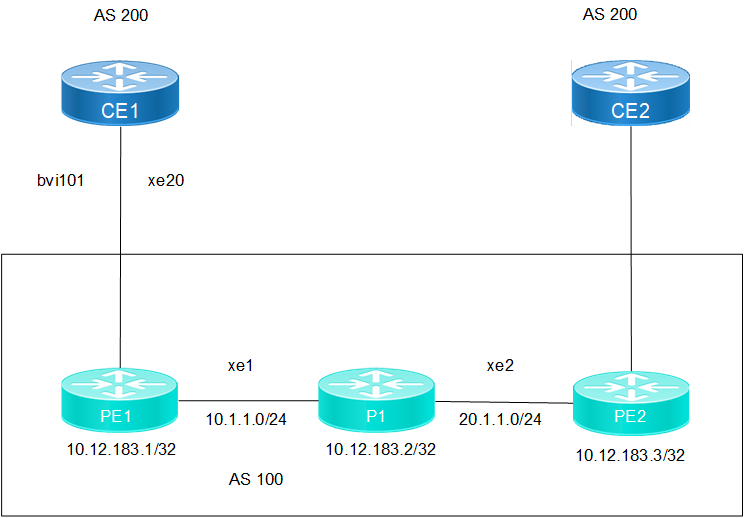Configuration
Topology
The sample topology includes Edge nodes (PE1 and PE2), core Node (P1), and Customer Edge nodes (CE1 and CE2).
Figure 37. BVI Interface Topology

Before configuring BVI-6vPE, meet all the pre-requisite for the following nodes:
| • | Edge nodes: PE1 and PE2 |
| • | Core nodes: P1, P3, and P4 |
Configure CE1 Router
| 1. | Set up the interface with VLAN encapsulation and assign an IP address. |
Copy
CE1(config)#interface xe20.101
CE1(config-if)#encapsulation dot1q 101
CE1(config-if)#ipv6 address 2001::2/64
CE1(config-if)#commit
CE1(config-if)#exit| 2. | BGP Configuration with a neighbor in the same AS (200). |
Copy
CE1(config)# router bgp 200
CE1(config-router)# neighbor 2001::1 remote-as 100
CE1(config-router)#address-family ipv4 unicast
CE1(config-router-af)#neighbor 2001::1 activate
CE1(config-router-af)#exit-address-family
CE1(config-router)#commit
CE1(config-router)#exitConfigure PE1 Router
| 1. | Create a VRF instance (VRF101) and define route targets. |
Copy
PE1(config)# ip vrf VRF101
PE1(config-vrf)# rd 10.12.183.1:100
PE1(config-vrf)# route-target both 100:101
PE1(config-vrf)# commit
PE1(config-vrf)# exit| 2. | Configure the access port with VLAN encapsulation and enable rewriting. |
Copy
PE1(config)#interface xe20.101 switchport
PE1(config-if)#encapsulation dot1q 101
PE1(config-if)#rewrite pop
PE1(config-if)# commit
PE1(config-if)# exit| 3. | Set up a BVI for VRF forwarding. |
Copy
PE1(config)# interface bvi101
PE1(config-if)#ip vrf forwarding VRF101
PE1(config-if)#ipv6 address 2001::1/64
PE1(config-if)# commit
PE1(config-if)# exit| 4. | Configure BGP with internal (PE) and external (CE) neighbors. |
Copy
PE1(config)# router bgp 100
PE1(config-router)# neighbor 10.12.183.3 remote-as 100
PE1(config-router)# neighbor 10.12.183.3 update-source lo
PE1(config-router)#address-family ipv4 unicast
PE1(config-router-af)#neighbor 10.12.183.3 activate
PE1(config-router-af)#exit-address-family
PE1(config-router)#address-family vpnv4 unicast
PE1(config-router-af)#neighbor 10.12.183.3 activate
PE1(config-router-af)#exit-address-family| 5. | Enable VPNv4 and redistribute connected routes. |
Copy
PE1(config-router)#address-family ipv4 vrf VRF101
PE1(config-router-af)#redistribute connected
PE1(config-router-af)#neighbor 2001::2 remote-as 200
PE1(config-router-af)#neighbor 2001::2 activate
PE1(config-router-af)#exit-address-family
PE1(config-router)#commit
PE1(config-router)#exit| 6. | Set up a bridge domain to associate the interface with BVI. |
Copy
PE1(config)# bridge-domain 101
PE1(config-bridge-domain)#interface xe20.101
PE1(config-bridge-domain)#routed-interface bvi101
PE1(config-bridge-domain)#commit
PE1(config-bridge-domain)#exitConfigure PE2 Router
| 1. | Create the same VRF instance (VRF101) with route targets. |
Copy
PE2(config)# ip vrf VRF101
PE2(config-vrf)# rd 10.12.183.3:100
PE2(config-vrf)# route-target both 100:101
PE2(config-vrf)#commit
PE2(config-vrf)#exit| 2. | Configure the access port with VLAN encapsulation and VRF forwarding. |
Copy
PE2(config)# interface xe30.101
PE2(config-if)#encapsulation dot1q 101
PE2(config-if)#ip vrf forwarding VRF101
PE2(config-if)#ipv6 address 3001::1/64
PE2(config-f)# commit
PE2(config-f)# exit| 3. | Assign an IP address to the interface. |
Copy
PE2(config)# router bgp 100
PE2(config-router)# neighbor 10.12.183.1 remote-as 100
PE2(config-router)# neighbor 10.12.183.1 update-source lo
PE2(config-router)#address-family ipv4 unicast
PE2(config-router-af)#neighbor 10.12.183.1 activate
PE2(config-router-af)#exit-address-family| 4. | Configure BGP with internal (PE) and external (CE) neighbors. |
Copy
PE2(config-router)#address-family vpnv4 unicast
PE2(config-router-af)#neighbor 10.12.183.1 activate
PE2(config-router-af)#exit-address-family| 5. | Enable VPNv4 and redistribute connected routes. |
Copy
PE2(config-router)#address-family ipv4 vrf VRF101
PE2(config-router-af)#redistribute connected
PE2(config-router-af)#neighbor 3001::2 remote-as 200
PE2(config-router-af)#neighbor 3001::2 activate
PE2(config-router-af)#exit-address-family
PE2(config-router)#commit
PE2(config-router)#exitConfigure CE2 Router
| 1. | Set up the interface with VLAN encapsulation and assign an IP address. |
Copy
CE2#configure terminal
CE2(config)#interface xe30.101
CE2(config-if)#encapsulation dot1q 101
CE2(config-if)#ipv6 address 3001::2/64
CE2(config-if)#commit
CE2(config-if)#exit| 2. | Configure BGP with a neighbor in the same AS (200). |
Copy
CE2(config)# router bgp 200
CE2(config-router)#neighbor 3001::1 remote-as 100
CE2(config-router)#address-family ipv4 unicast
CE2(config-router-af)#neighbor 3001::1 activate
CE2(config-router-af)#exit-address-family
CE2(config-router)#commit
CE2(config-router)#exit